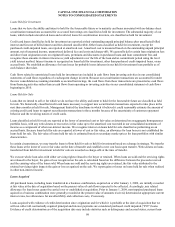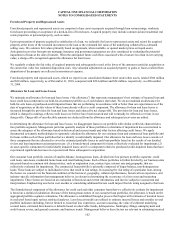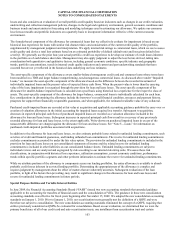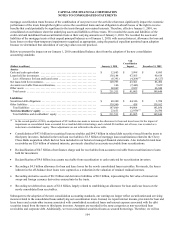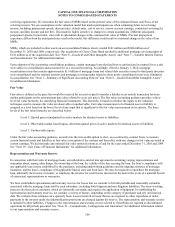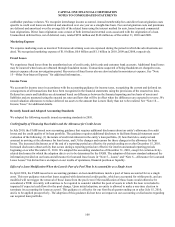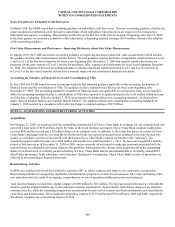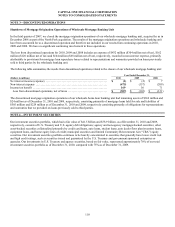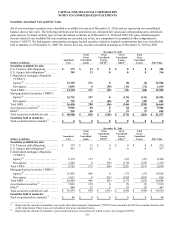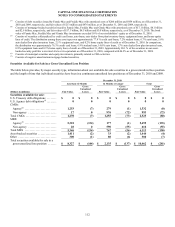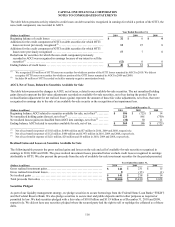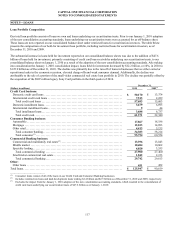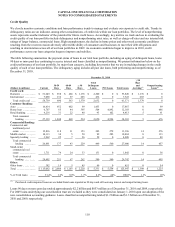Capital One 2010 Annual Report Download - page 128
Download and view the complete annual report
Please find page 128 of the 2010 Capital One annual report below. You can navigate through the pages in the report by either clicking on the pages listed below, or by using the keyword search tool below to find specific information within the annual report.CAPITAL ONE FINANCIAL CORPORATION
NOTES TO CONSOLIDATED STATEMENTS
108
cardholder purchase volumes. We recognize interchange income as earned. Annual membership fees and direct loan origination costs
specific to credit card loans are deferred and amortized over one year on a straight-line basis. Fees and origination costs and premiums
are deferred and amortized over the average life of the related loans using the interest method for auto, home loan and commercial
loan originations. Direct loan origination costs consist of both internal and external costs associated with the origination of a loan.
Unamortized deferred fees, net of deferred costs, totaled $250 million and $148 million as of December 31, 2010 and 2009.
Marketing Expense
We expense marketing costs as incurred. Television advertising costs are expensed during the period in which the advertisements are
aired. We recognized marketing expense of $1.0 billion, $0.6 billion and $1.1 billion in 2010, 2009 and 2008, respectively.
Fraud Losses
We experience fraud losses from the unauthorized use of credit cards, debit cards and customer bank accounts. Additional fraud losses
may be incurred when loans are obtained through fraudulent means. Transactions suspected of being fraudulent are charged to non-
interest expense after an investigation period. Recoveries of fraud losses also are also included in non-interest expense. See “Note
15—Other Non-Interest Expense” for additional information. .
Income Taxes
We account for income taxes in accordance with the accounting guidance for income taxes, recognizing the current and deferred tax
consequences of all transactions that have been recognized in the financial statements using the provisions of the enacted tax laws.
Deferred tax assets and liabilities are determined based on differences between the financial reporting and tax basis of assets and
liabilities and are measured using the enacted tax rates and laws that will be in effect when the differences are expected to reverse. We
record valuation allowances to reduce deferred tax assets to the amount that is more likely than not to be realized. See “Note 18—
Income Taxes” for additional details.
Recently Issued and Adopted Accounting Standards
We adopted the following recently issued accounting standards in 2010.
Credit Quality of Financing Receivables and the Allowance for Credit Losses
In July 2010, the FASB issued new accounting guidance that requires additional disclosures about an entity’s allowance for credit
losses and the credit quality of its loan portfolio. The guidance requires additional disclosure to facilitate financial statement users’
evaluation of the following: (1) the nature of credit risk inherent in the entity’s loan portfolio, (2) how that risk is analyzed and
assessed in arriving at the allowance for loan losses, and (3) the changes and reasons for those changes in the allowance for loan
losses. The increased disclosures as of the end of a reporting period are effective for periods ending on or after December 15, 2010.
Increased disclosures about activity that occurs during a reporting period are effective for interim and annual reporting periods
beginning on or after December 31, 2010. We adopted the accounting standard as of December 31, 2010, except for certain activity-
related disclosures for which the adoption date is yet to be determined by the FASB. The adoption of this new standard enhanced the
information provided on our loans and allowance for loan and lease losses in “Note 5—Loans” and “Note 6—Allowance for Loan and
Lease Losses” but did not have an impact on our results of operations, financial position or liquidity.
Effect of a Loan Modification When the Loan Is Part of a Pool That Is Accounted for as a Single Asset
In April 2010, the FASB issued new accounting guidance on loan modifications inside a pool of loans accounted for as a single
asset. This new guidance states that loans acquired with deteriorated credit quality, which are accounted for within pools, and are
modified will not trigger the removal of those loans from the pool even if the modification of those loans would otherwise be
considered a TDR. An entity will continue to be required to consider whether the pool of assets in which the loan is included is
impaired if expected cash flows for the pool change. Upon initial adoption, an entity is allowed to make a one-time election to
terminate its accounting for loans as a pool. This guidance is effective for our first fiscal quarter ending on or after July 15, 2010,
and is to be applied prospectively. The adoption of this guidance did not have an impact on our accounting or disclosures regarding
our acquired loan portfolio.


